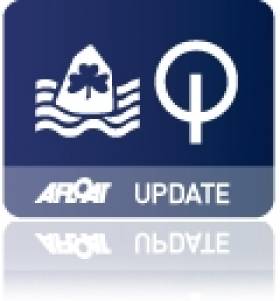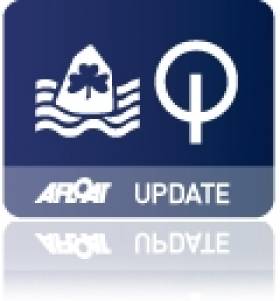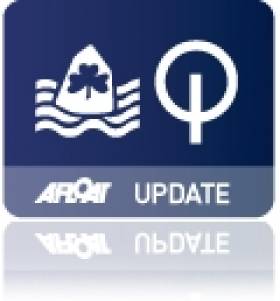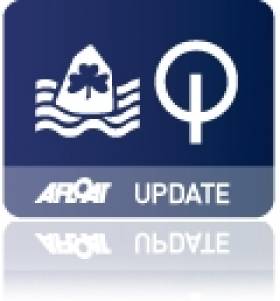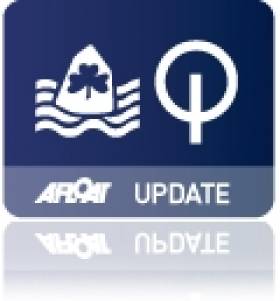Displaying items by tag: Optimist
Irish Team Drop Back at Dublin Bay Optimist Europeans
#OppiEuros2014 – Irish boys could not maintain their two top-20 rankings in today's second day of competition at the Optimst European Championships on Dublin Bay where there have been dramatic changes in positions at the Royal St. George hosted event.
The winds were marginally lighter but it may also be that our visitors have quickly learned how to sail Dublin Bay.
However James McCann of Royal Cork Yacht Club now in 26th place and Loghlen Rickard of the National Yacht Club in Dun Laoghaire (NYC) in 51st have an excellent chance of making the cut to the Gold Fleet (top third for boys, top half for girls) following tomorrow's racing when the worst single race result is discarded.
The new leader of the boys' event is Kasper Nordenram of Rörviks Sailing Club (on a lake in central Sweden). Competition at the top of the fleet has grown very close with Kasper leading from Enzo Balanger from Guadeloupe, sailing for France, and Pablo Lujan of C.N. Javea, Spain.
Overnight leader Jacob Ahlers had a poor third race but bounced back to place 4th in the fourth race of the day and may benefit when the first discard is taken, as may reigning champion Tytus Butowski of Poland.
In the girls' event the Irish had mixed fortunes. Clare Gorman who had been 16th after the first day slipped back to 32nd. However Gemma McDowell (Malahide Yacht Club), Dara Donnelly (NYC) and Sarah Cudmore (Royal Cork Yacht Club) all improved their rankings and now also lie in top 60 of the 101 boat fleet.
Iset Segura from the Catalan club of Arenys de Mar leads with a win in Race 3 and a lead of 20 points over the overnight leader Josefine Akesson (Sweden). Brazilian Olivia Belda and Ebru Bolat of Romania are next, within a point of each other.
However the rather lighter winds today had a significant effect on the overnight results lower down the fleet. Reigning champion Mara Turín of Slovenia who had disappointed on day one registered two 6th places and others who may have benefited include the Asian girls such as Lisa Nukui (Japan) (scores 1 and 8) and Shyn Ee Phua (Singapore, 7 & 8).
The best results of the day came from the British girl Fenella Bennett (Royal Lymington Yacht Club) with two second places. She commented "It took a while to come to terms with the waves on Dublin Bay but now I found that sailing slightly less close to the wind pays off".
With good races tomorrow they will have an excellent chance of making the cut for the gold fleet. This will take place after tomorrow's racing when the half of the fleet with the best five results from the six races will form the gold fleet.
#OptiEuros2014 – Ireland has got off to an exceptional start at the massive 254–boat Optimist European Championships on Dublin Bay this afternoon.
Exceeding expectations of top half results, the top Irish under–16 sailors are placed tenth and 17th in the 153 boat boys' fleet after the first two races where winds gusted over 20–knots.
James McCann of Royal Cork Yacht Club scored seventh in both races with team-mate Loghlen Rickard of the National Yacht Club (NYC) scoring eight & ten.
In the 101 boat girls fleet, Clare Gorman (NYC) lies 16th after scoring 12 and seven. Alix Buckley of Skerries scored a superb second in her opening race and currently lies 40th.
The boys' event after two races is being led by 2013 German national champion Jacob Ahlers from MSC Hamburg followed by, in the open ranklist, Iagor Franco of Brazil and Campbell Patton of Bermuda.
In 4th and 5th (2nd and 3rd in the European closed event) are Elias Odrischinsky (POL) and another German Lennart Kuss.
Defending champion Tytus Butowski (POL) started his championship well with a fourth place. He showed great boat–speed both up-and down-wind and could have won except for a conviction that the left was the favoured side of both beats. His second race was less successful, placing 17th.
In the girls' event Josefine Åkesson of Sweden leads from Iset Segura of Spain and Senef Seder (TUR).
Results here
#oppieeuros2014 – Young sailors from 44 countries attended the formal opening of the European open championship of the Under-16 Optimist sailing class at Dun Laoghaire, County Dublin today.
The 253 youth sailors with their coaches and team leaders walked in a colourful procession from the Royal Marine Hotel where most of them are staying to the Town Hall where they were greeted by An Cathaoirleach Marie Baker. Eamon Gilmore T.D. spoke of the importance of sailing to the local economy and Frank O'Beirne, chairman of the organising committee of the future of lifetime sailing for the young participants.
The sailors then processed to the club where a welcoming speech was given by Liam O'Rourke, commodore of the Royal St. George with a reply by Lady Stanley of Alderley, vice-president for Europe of the International Optimist Dinghy Association. The official event flag was raised by Grace O'Beirne, one of the 14-sailor Irish team.
Many of the teams will have been encouraged by the presence of the ambassadors of their countries, those from Argentina, Austria, Belgium, Brazil, Bulgaria, Canada, Denmark, France, Great Britain, India, Netherlands, Norway, Romania and the deputy chef de mission of Russia.
These are just a few of the countries represented, 32 of them from Europe where each country may enter seven sailors including three of each gender, and 12 from non-European nations who can enter four.
The Optimist Dinghy's Good News Story Sails Into Dublin Bay
#OppiEuros2014 – This weekend sees a truly international sailing event taking shape in Dun Laoghaire, with the Optimist European Open Championship attracting 250 young sailors from 44 nations (32 European, 12 others). They will take to the waters of Dublin Bay in a little boat which is one of the key strands in the fabric of world sailing. W M Nixon takes a look at the Opty back-story, and outlines the front runners in the Euros and the home team.
Once upon a time, there was an American magazine called The Saturday Evening Post, which lived up to its name by arriving in millions of households across America in the last postal delivery of each week. It provided a focus for family life with its homely mixture of entertaining, informative and educational articles. And as it was the most widely circulated weekly in America, it had the resources to employ talented artists who each week evocatively illustrated the very best of American life with a strong family slant.
But it's a long time now since the demand for post and printed material were such that a publication of this quality could be a viable proposition. The Saturday Evening Post ceased to be a weekly in 1963, and for a while was reduced to a quarterly. These days, it is published six times a year as an exercise in nostalgia by The Saturday Evening Post Society. But while it may now only be a shadow of its former self, the weekly illustrations produced at its height by its team of artists have endured as highly-regarded works of art in themselves. And nothing more perfectly captured the essence of American home and small town life at its very best than the paintings of Norman Rockwell who, in a 50 year career with the magazine, created more than 300 of The Saturday Evening Post's distinctive covers. It was popular art at its very best.
Yet even an all-embracing magazine of this calibre could not cover every good news story going on in America during its glory years from 1920 to 1960, and there were some gems which escaped Rockwell's technically brilliant attention. So if there's ever a competition to create The Greatest Norman Rockwell Picture Never Painted, let us suggest that "Building The First Optimist Dinghy in Clearwater, Florida" should be right up there for consideration. Indeed, as the International Optimist Dinghy Association is such a thriving, prosperous and global body, I'd suggest they commission it themselves, as doing so would create a neat story in itself.
"Neat" is the word which most often comes up in talk of the Optimist, and of course in America it carries wider connotations than the simpler European notion of tidiness. At just 8ft long, the little sailing pram is neat but deceptively simple, and the people who brought it into being in Florida in August 1947 were quiet geniuses who did much good work mostly by stealth, but knew when to beat a drum when it suited their cause.
It started with a recently returned World War II veteran, Major Clifford A McKay, noting that while his son Clifford Jnr aged 12 much enjoyed the landbound wheeled soapbox races for young people organized by the Clearwater Optimist Club (one of those classically American community groups like the Rotarians and the Lions), the boy's most strongly developing interest was sailing as a crew in the local Snipe dinghy class.
Back in 1947, even in Florida there wasn't the money to splash about on any sport in which your child showed an interest, so the Major got fired up with the notion of creating the cheapest possible sailing boat – a floating soapbox - that could get the local young people afloat in their own boats. His own interest in boats was purely for fishing, but he proved he could turn his inventive mind to anything, and he outlined his requirements to the local boatbuilder Clark Mills, who happened to be going through a quiet late summer period at his workshop.

Clark Mills (1915-2001), designer and builder of the first Optimist
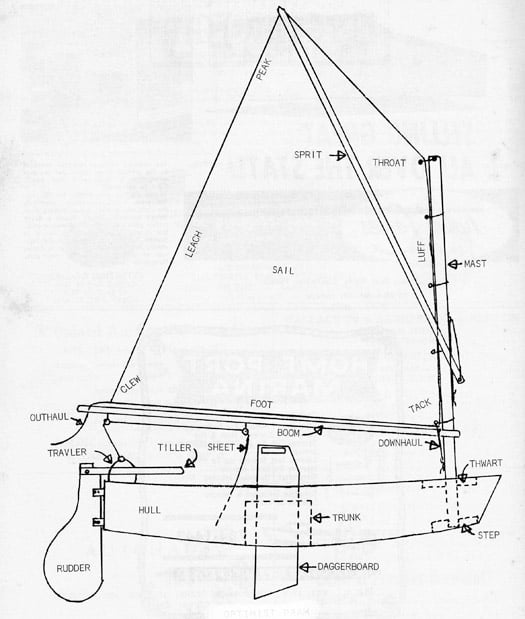
The first drawings for the Optimist – it was to be built with two sheets of 8 x 4 plywood
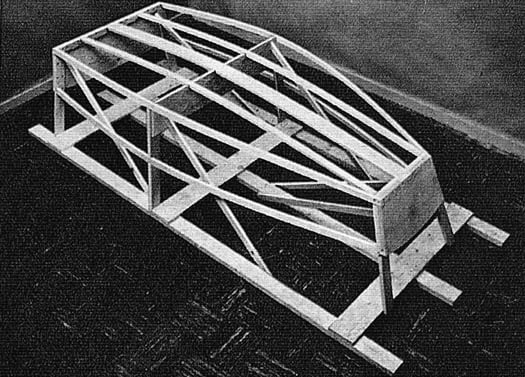
This framework was the mould on which the first Optimists were built by Clark Mills
Within a fortnight, Mills - the quintessential all-American can-do character – had created a bright red 8ft sailing pram, the dimensions dictated by the fact that it was to be made from two sheets of 8ft x 4ft ply, the rig dictated by the utter simplicity of a sprit setup, as they'd hoped to make the sail from a square bedsheet.
The bedsheet was the first notion to be scrapped – the local sailmaker and his wife were soon producing economy sails. But as for the basic design, it was a winner from the start. Yet even in his wildest dreams, young Clifford Mackay Jnr could never have thought, as he sailed that first able little prototype out on Clearwater Bay, that he was sailing a boat which would go on to become a cornerstone of global sailing.
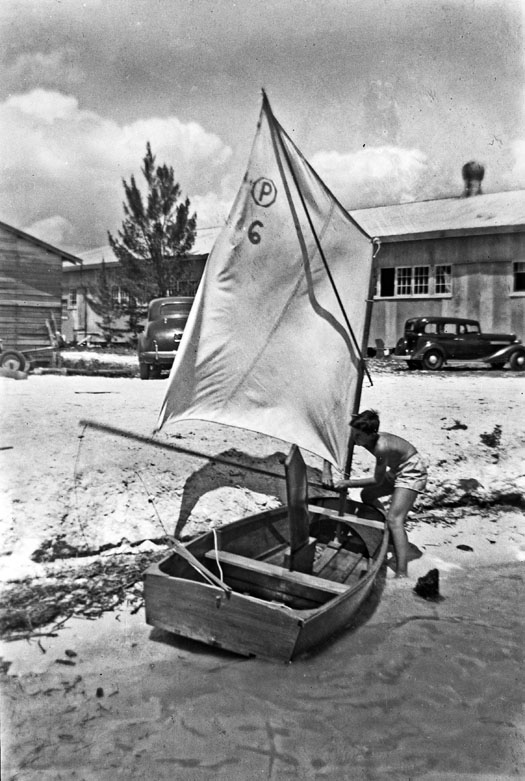
Young Clifford McKay with one of the first Optimists at Clearwater Bay, Florida in 1947
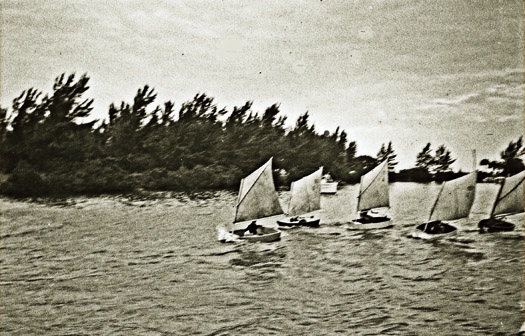
The fleet is racing....thanks to sponsorship from neighbourhood businesses in 1947, the Clearwater Optimist fleet was soon in action
Local needs came first. The class took off in Clearwater when Major McKay and his committee secured sponsorship from neighbourhood firms for the building of 28 boats. That it was all happening outside the stuffy constraints of established sailing became evident when the local paper reported an early series. It simply mentioned that the Optimist prams of the Clearwater Sun and WTAN Radio Station had tied on points. Blatant sponsorship and advertising were anathema to traditional yachting (even if Lipton and Jameson had boosted sakes of their tea and whiskey with sailing success), but the idea that the sponsor would be named but the helmsman ignored went way beyond the pale.
Be that as it may, it worked in getting the show on the road, and the Clark Mills Boat Works was soon churning out Optimists, while Major McKay was successfully promoting the idea throughout Florida. Reaching a wider public didn't dent the little boat's good image in any way - in fact, it enhanced it. Other builders were to find that building a competitive Optimist was in no way as easy as "Clarkie" Mills made it seem, and it was recalled that his Boat Works had produced some super-fast Snipes.
As for Mills himself, he had no doubt his interpretation of McKay's outline had produced something very special, and quipped: "I think I'm the best designer in the United States. I'm damned good. I've got the splinters and the backache to prove it....."
It might have been out of character for him to admit the profound satisfaction that the Optimist's success in opening up the world of boats had given him in his varied life from 1915 to 2001, but he couldn't suppress his love of sailing: "A boat, by God, it's just a gleamin' beautiful creation. And when you pull the sail up on a boat, you've got a little bit of somethin' God-given. Man, it goes bleetin' off like a bird wing, you know, and there's nothin' else like it."
There were other small boats becoming available which were broadly similer to the Optimist in concept, and in Ireland at Skerries local sailor Brian Malone, a naval architect with BIM (the Sea Fisheries Board) created a tiny children's sailing pram dinghy which he called the Measle, as every kid would have it sooner or later. But while the Measles had to be robustly built to cope with Irish conditions, by comparison the Optimists seemed light as a feather, and by the 1950s they were going international in an unexpected direction, having taken off big time in Scandinavia.
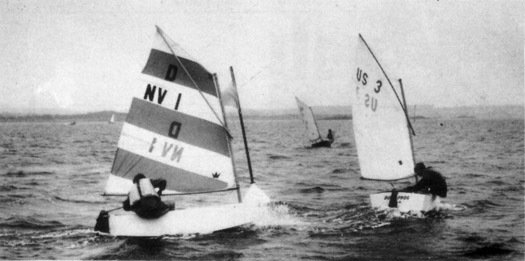
Rapid international expansion began when the Optimist became widely accepted in Scandinavia in the 1950s. By 1967-68, Peter Warren of Denmark (left) was twice world champion, using an Elvstrom sail.
That such a stronghold of classic yacht design should adopt the utilitarian little American boat speaks volumes for the Optimist's versatility, and the fact that at only 8ft, moving the boats around was not a major logistical challenge. Nevertheless some countries held out against the Opties' easy appeal. But by the early 1960s even the traditional strongholds in the south of England were sharing the momentum, and a regatta in the Hamble River in 1962 set the seal on the Optimist's British success, with the first fibreglass boats also starting to appear.

This regatta in the River Hamble in 1962 confirmed the Optimist's growing popularity in England
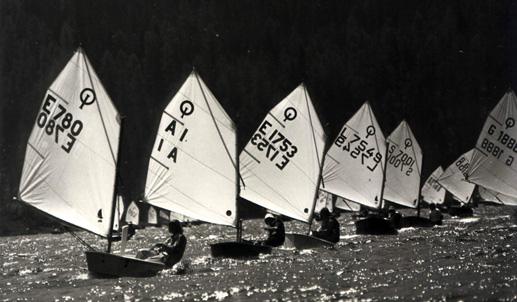
A mighty long way from a creek in Florida – a major Optimist championship under way at St Moritz in Switzerland
Today, practically every sailing family in the world goes through its Optimist phase while there are kids under the age of 15 in the lineup, with the prime years with national and international aspirations being 13-15. Thus the most intense Optimist individual window is only two to three years. In some families, the involvement can be almost total, while in others it's just a case of having an Optimist or two about the place.
We were in this situation for about twelve years in all, and it ended on something of a high with the youngest son showing his entrepreneurial skills by becoming a part-time Opty dealer long before he'd a driving licence. This meant his parents had to drive him to other sailing centres where the class was developing, and then stay in the background while he struck a deal with some nervous parent anxious to provide a hot boat for their demanding child. Major Clifford McKay and Clarkie Mills – you've a lot to answer for........
Ireland has punched way above her weight in Optimist involvement, and the development of the international association has seen key players such as Robert and Helen-Mary Wilkes of Howth, and Curly Morris of Larne, making dedicated input in order to keep the Optimist class relevant to the needs of modern sailing, while Robert Wilkes took time out to record the history of the class in a gem of a book which has provided much of the material for our look at the early years.
Adaptation and innovation have been central to the Optimist's continuing success. Thus although the convenient size of the little boat has been a bonus in times past, even at just 8ft long it is now becoming so expensive to move about internationally that one of the attractions of the Europeans at Dun Laoghaire will be the provision of a large charter fleet already on site.
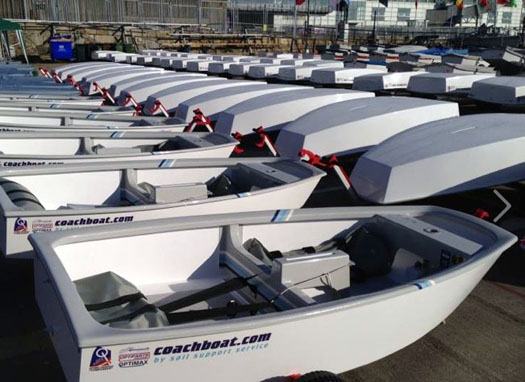
A glimpse of the future – the charter boats which will be used at Dun Laoghaire by a significant number of young sailors
As for the site, Dun Laoghaire has enthusiastically woken up to the fact that it can provide the kind of club and accommodation package which topline modern events expect. The Royal St George Yacht Club is the host, while the Royal Marine and Kingston Hotels have combined forces to provide what is in effect an Olympic village.
If you want the ultimate measure of the Optimist's central role in sailing, it's worth noting that six of the female European Olympic dinghy medallists in London 2012 had participated in Optimist European Championships, the male "graduates" included triple Olympic medalist Iain Percy, and worldwide you'll find that top people in sailing in many different areas of the sport are more than happy to remember their Opty days - it's just part of what our sport is all about.
In the coming days, it's the defending girls' champion, Maria Turin of Slovenia, who'll be the main focus of attention, for if she succeeds, it will make it three in a row. As for the boys, Tytus Butowski of Poland is the defending champion.
So far, Ireland's best result came in 1992 when Laura Dillon of Howth was fourth, while in 2011 Peter McCann (Royal Cork) placed 5th. Like youth itself, there's something essentially ephemeral about top level Optimist racing, but for the year or three that's in it, Ireland's lineup for 2014 is: Sarah Cudmore (Royal Cork), Dara Donnelly (National YC), Gemma McDowell (Malahide YC), Grace O'Beirne (Royal St George YC), Clare Gorman (National YC), Harry Bell (Royal North of Ireland YC), Alex Buckley (Skerries SC), Michael Carroll (Kinsale YC), Loghlen Rickard (National YC), James McCann (RCYC), Alex O'Grady (Howth YC), Daniel Hopkins (HYC), Jamie McMahon (HYC) and Peter Fagan (SSC).
#opti – A consistent showing by Harry Durcan who never fell out of the top three, despite very tricky conditions, at last weekend's Optimist Leinster Championships gave the Royal Cork sailor the title.
Durcan will be Ireland's sole representative at the Argentinian World Championships this October.
Second place at the Royal Irish hosted eveny went to Dara Donnelly of the National Yacht Club and third place to a visiting Maltese sailor. In the senior silver fleet Paddy Cunnane from Dingle Sailing club earned his win with Sarah Fogarty and Kate Darcy second & third in Silver senior fleet.
Optimist class interest now focuses on the European Championships hosted next week at the Royal St. George Yacht Club in Dun Laoghaire.
Senior fleet results available to download below.
#optimisteuros2014 – Ireland is a fortnight away from its staging of one of the largest sailing events of the season when the Optimist dinghy European Championships kick off at the Royal St. George Yacht Club on Dublin Bay from 13 to 20 July.
The club have a new website up and running for the event here
250 sailors from 44 nations make it the second highest entry on record for the world's most popular junior sailing class, with over 150,000 boats registered.
Thirty-two European countries have entered teams of up to seven sailors each and they are joined by teams of up to four sailors each from twelve non-European countries.
The great majority of the sailors will be aged 13-15. They have been selected from trials and sometimes pre-trials involving several thousand sailors. Unlike at other Optimist events the girls – just over 100 of them - race separately from the boys and this gives great emphasis to their event. Indeed all six of the female European Olympic dinghy medalists in London 2012 had participated in Optimist European Championships.
Male graduates of the event include triple Olympic medalist Iain Percy (GBR).
The event was last held in Ireland in 1993 at Newtownabbey. Only 27 countries (21 European) participated then, mostly because few East Europeans were able to travel but also due to the growth of Optimist sailing in countries such as Singapore, India, Hong Kong, Australia and New Zealand in the last twenty years. Indeed Singapore, where sailing is a major school sport, may well challenge for the open prizes. First-time entrants are Iceland and Antigua.
Individual prospects are hard to identify with many of last year's sailors now over age, but Mara Turín of Slovenia won both the 2012 and 2013 championships and could become the first girl ever to win three times. 2013 boys champion Tytus Butowski of Poland will also be trying to retain his title.
One of the key factors in the choice of Dun Laoghaire was the ability to house all participants in two hotels close to the venue, creating an Olympic village type environment ashore perfect for making the friendships so valuable in this lifetime sport.
#opti – With only three races sailed and no discards applied there were some big casualties at the Skerries based Ulster Optimist dinghy championships today, including a lowly ninth overall for Cork's Harry Durcan, who will be Ireland's only representative at the World Championships in Argentina later this year.
There was no racing on Saturday due to flat calm conditions but thanks to a first gun at 10.00am today three races were managed in the light winds.
In the 46–boat senior fleet racing a consistent Grace O'Beirne of the Royal St. George Yacht Club was the winner with a 2,2,1 scored. Royal Cork's James McCann was second with a 1,3, 2.
In the junior fleet, Howth's Jamie McMahon won from Michael O'Suilleabhan of Kinsale.
Full results availalbe to download below.
#optimist – Royal Cork's Harry Durcan, the only Irish sailor heading to the World Championships in Argentina later this year, emerged the clear winner of the 39–boat senior fleet at the Optimist Class Connaught Championships at Galway Bay Sailing Club at the weekend. After five races sailed in the 39–boat fleet, the 15–year–old had three race wins to have a clear 13 nett points ahead of Malahide's Gemma McDowell in second overall. Third was National Yacht Club sailor Loghlen Rickard from Dun Laoghaire.
Blustery conditions for the youngsters meant there was no racing for the novice 26–boat regatta fleet on Saturday but the brave kids who moved up to Junior fleet (46 competed) learnt lots but there was plenty of retirals as results below show.
Full results for the combined fleet of over 111 sailors are below as jpeg files.
#optimist – A top Irish youth sailor has opted out of his place on the European Optimist team in favour of a place on the startline at the world championships in October.
Irish champion sailor Harry Durcan (14) from Royal Cork and Baltimore Sailing Club who came third at the trials this year has made the tough choice to go to the worlds on his own as the IODAI are not sending a team this year.
Harry has opted to go to the Worlds instead of the Europeans as you cannot attend both under Irish Optimist Dinghy Association (IODAI) rulings.
Normally the top five finishers at trials go to the Worlds but this year IODAI are not supporting a team because it's been held during school term.
The World Championships this year are on in San Isidro, Buenos Aires, Argentina in October. Durcan's preparations will be to train with the Irish 2014 Optimist European Team from now until the European event in Dun Laoghaire in order to help them and himself. He will also attend all the Irish regional events. He then plans to train with the Danish Team and their coach Dennis Passke for the week before the Europeans in Dun Laoghaire. He will then travel to Weymouth for the British Nationals at the 2012 Olympic Games venue and from there to Germany for the German nationals in August.
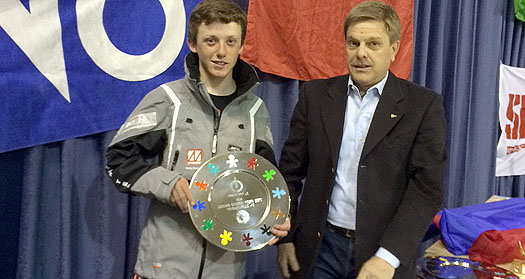
Harry picks up a top Optimist prize in Italy
He goes as the only Irish sailor to Argentina but has completed two world championships before, in Lake Garda in 2013 and the Dominican Republic in 2012.
Durcan also competed an event in Riva Del Garda at Easter and placed 9th out of 800 sailors, the best ever result for an Irish sailor at such an event. In March he was in Oman for an event with some of the top sailors from Europe. 'I am now looking forward to a fun Summer ahead and getting some training and racing under my belt' he told Afloat.ie
#optimist – 14 young sailors from ten different Irish yacht clubs make up the team to represent Ireland at the Optimist Europeans that will be held in the home waters of Dun Laoghaire in July.
Skerries Sailing Club sailor Peter Fagan (14) was the overall winner of the Optimist trials that concluded in blustery conditions at the Royal St. George YC at the weekend. Over half of the 62–boat fleet did not complete the final race as gusts of over 30–knots hit the fleet. Full results downloadable below as a jpeg file.
The team who have been chosen by the International Optimist Dinghy Association of Ireland to represent Ireland at the Optimist European Championships in Dun Laoghaire in July 2014 are Sarah Cudmore (RCYC), Dara Donnelly (NYC), Gemma McDowell (MYC), Grace O'Beirne (RStGYC), Clare Gorman (NYC), Harry Bell (RNIYC), Alix Buckley (SSC), Michael Carroll (KYC), Loghlen Rickard (NYC), James McCann (RCYC), Alex O'Grady (HYC), Daniel Hopkins (HYC), Jamie McMahon (HYC), Peter Fagan (SSC).
A development squad has also been chosen: Sarah Levie (LDYC / KYC), Emma Parker (SSC), Michael O'Suilleabhain (KYC), Tom Keal (RCYC), Chris Bateman (RCYC), Jamie O'Grady (HYC), Cathal O'Regan (RCYC), Caoimhe Foster (RCYC), Nicola Ferguson (NYC), Hugo Kennedy (RStGYC).

Irish development squad: Sarah Levie (LDYC / KYC), Emma Parker (SSC), Michael O'Suilleabhain (KYC), Tom Keal (RCYC), Chris Bateman (RCYC), Jamie O'Grady (HYC), Cathal O'Regan (RCYC), Caoimhe Foster (RCYC), Nicola Ferguson (NYC), Hugo Kennedy (RStGYC). Photo: Gareth Craig
With just under three months left to the opening ceremony of the Optimist European Championships, the Royal Saint George Yacht Club is preparing itself for a record entry.
To date 43 countries have entered teams totalling 245 competitors and 80 coaches and team leaders.
In addition to the 32 European teams, they are also welcoming 11 international teams as far afield as Antigua, Australia, Bermuda, Brazil, Canada, Hong Kong, India, Japan, New Zealand, Singapore, and USA.


























